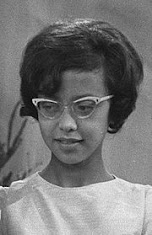Byrdie Green (occasionally credited as Birdie Green) (1936 – April 26, 2008) was a jazz and R&B singer who never got the praise she deserved, even years after her death. Green hopped around labels like Roulette and Twentieth Century Fox cutting singles, but it was her album work on the Prestige label that garnered all the attention thanks to her collaboration with organist Johnny "Hammond" Smith.
Byrdie
Green was born Bertha Green in Detroit, Michigan. The daughter of a Baptist
minister, she sang first in her father's church. Later she went to New York
City and performed in clubs, and at one time was a protege of Ruth Brown. She
was the first artist signed to Perri Records, who debuted with Green's single
"Now is the Time For Love" b/w "Be Anything." She began
recording with End Records and 20th Century Fox Records, cutting singles
"How Come" b/w "Tremblin'" and "Get a Hold of
Yourself" b/w "Don't Take Your Love From Me" in the early 1960s.
The song "Get a Hold of Yourself" is a blend of blues and gospel, and
Billboard calls it "a slew rockaballad" and "her strongest
item."
Green
performed at many popular venues, including The Apollo, Baby Grand, The Cookery
and Pier 52, as well as Rutgers University, in Boston and in Bermuda. Around
1965, she was hired by organist Johnny "Hammond" Smith and signed
with Prestige Records. Smith's The Stinger Meets the Golden Thrush was released
in 1966, with Green singing on "They Call It Stormy Monday" and
"If I Ruled The World." Green was acclaimed as "an excellent
blues singer", "with a powerfully persuasive voice".
That
same year Green released her first solo full-length The Golden Thrush Strikes
at Midnight, featuring Smith on organ on "Goin' Out of My Head,"
"The Shadow of Your Smile" and "Hurt So Bad." Billboard
said Green is "a soul singer with a lot to say and who says it well with a
touch of the blues, jazz and gospel." Another reviewer said, "Miss
Green displays here a skill that enables her to revitalize not only hard-core
blues numbers, but also tried pop items .... She sings with much feeling no
matter what the tune, and ... she emotes with a conviction few modern blues
interpreters have shown."
She
released two more albums, I Got It Bad (And That Ain't Good) in 1967, which
featured Smith, Houston Person, Thornel Schwartz and Jimmy Lewis, and Sister
Byrdie! in 1968, which one reviewer called a "gem of soul, blues, and
gospel pinned down with Smith's patented organ grooves." Another described
it as "slow and moody with some presentations and steppin' out and really
telling you where it's at on the others ... always sounding so very
groovy."The same year, she appeared on a Nipsey Russell TV show, and, at a
performance in New York, was asked by Frank Sinatra to sing an extra set of
songs. Her voice was likened to Dinah Washington.
Green
took a break from her career to raise her two daughters, Deborah A. Murray and
Dardenella Braxton. She recalls in a 1986 interview in The New York Times
"it was necessary to stop, to give them guidance. I could always start my
career up again." Green returned to perform at Carnegie Recital Hall in a
show entitled Byrdie Green Sings the Blues on March 7, 1975, and continued to
work on tour with The Thad Jones/Mel Lewis Orchestra. A 1977 live review by The
New York Times John S. Wilson calls Green "a cool blues singer–crisp and
curt, with a wry, ironic touch–and, in the blues, she projects a warmth and
understanding." Another reviewer described her as having "strong,
beautifully modulated voice" with "a command of dynamics which
enables her to bathe a lyric in a running river of sound – soft, loud,
gradations between."
In the
1980s she sang at Lickety Split, Adam Clayton Powell Blvd, Sutton's and at
Jimmy Weston's, sometimes accompanied by Walter Bishop Jr. In 1989 she was
referred to by The New Yorker as the "little known singer Byrdie
Green" as she was joined on stage by Max Roach, Jimmy Heath and Carl
Coleman. In 1985 and 1996 she performed in the USA and all over Europe with
Linda Hopkins and Maxine Weldon in a show entitled "Black and Blue".
Byrdie"s health started to fade while she was still touring with the show. She later developed emphysema and was on oxygen 24 hours a day, and had to use a wheelchair. She died at Saint Luke’s Hospital on February 26, 2008, and was eulogized at Mountain. Neboh Church in New York City on Saturday, May 3, 2008. She was 72 years old.
(Edited
from Wikipedia & Prabook)



.jpg)






.jpg)












































